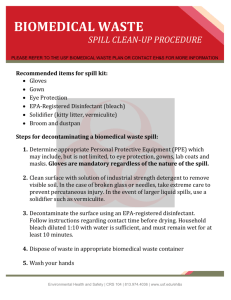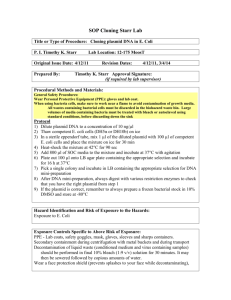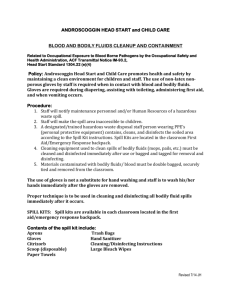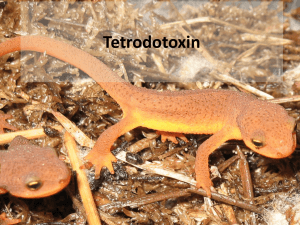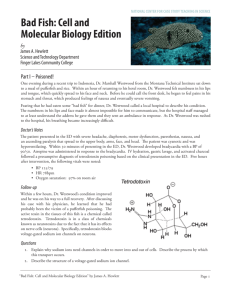Word - Environment, Health & Safety
advertisement
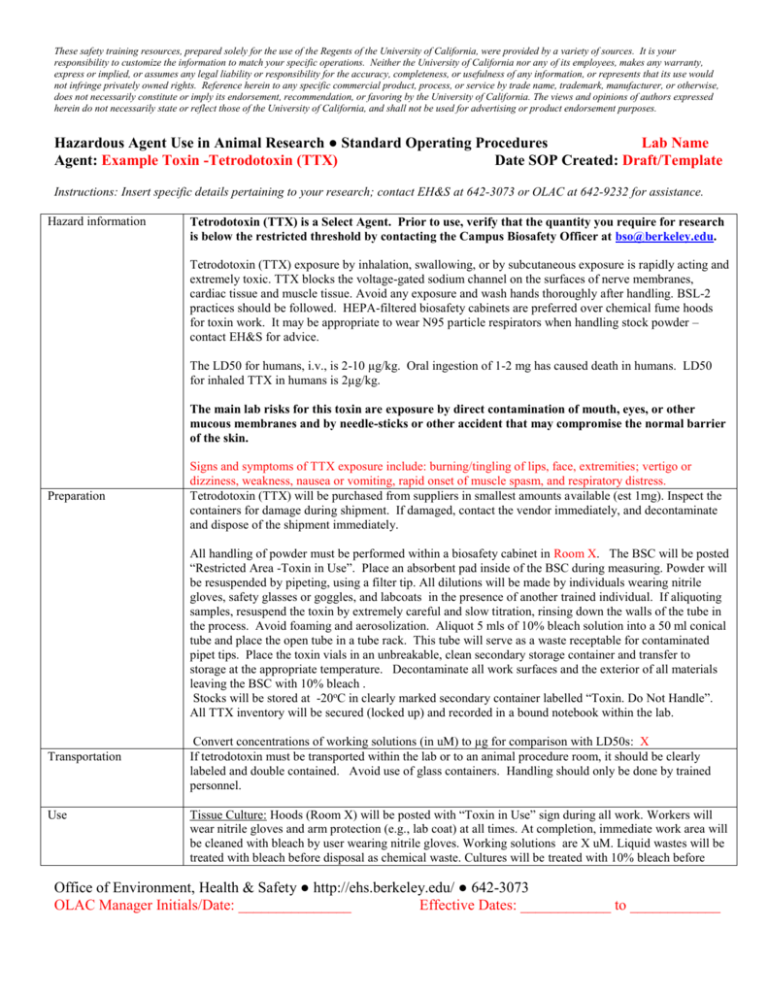
These safety training resources, prepared solely for the use of the Regents of the University of California, were provided by a variety of sources. It is your responsibility to customize the information to match your specific operations. Neither the University of California nor any of its employees, makes any warranty, express or implied, or assumes any legal liability or responsibility for the accuracy, completeness, or usefulness of any information, or represents that its use would not infringe privately owned rights. Reference herein to any specific commercial product, process, or service by trade name, trademark, manufacturer, or otherwise, does not necessarily constitute or imply its endorsement, recommendation, or favoring by the University of California. The views and opinions of authors expressed herein do not necessarily state or reflect those of the University of California, and shall not be used for advertising or product endorsement purposes. Hazardous Agent Use in Animal Research ● Standard Operating Procedures Lab Name Agent: Example Toxin -Tetrodotoxin (TTX) Date SOP Created: Draft/Template Instructions: Insert specific details pertaining to your research; contact EH&S at 642-3073 or OLAC at 642-9232 for assistance. Hazard information Tetrodotoxin (TTX) is a Select Agent. Prior to use, verify that the quantity you require for research is below the restricted threshold by contacting the Campus Biosafety Officer at bso@berkeley.edu. Tetrodotoxin (TTX) exposure by inhalation, swallowing, or by subcutaneous exposure is rapidly acting and extremely toxic. TTX blocks the voltage-gated sodium channel on the surfaces of nerve membranes, cardiac tissue and muscle tissue. Avoid any exposure and wash hands thoroughly after handling. BSL-2 practices should be followed. HEPA-filtered biosafety cabinets are preferred over chemical fume hoods for toxin work. It may be appropriate to wear N95 particle respirators when handling stock powder – contact EH&S for advice. The LD50 for humans, i.v., is 2-10 µg/kg. Oral ingestion of 1-2 mg has caused death in humans. LD50 for inhaled TTX in humans is 2µg/kg. The main lab risks for this toxin are exposure by direct contamination of mouth, eyes, or other mucous membranes and by needle-sticks or other accident that may compromise the normal barrier of the skin. Preparation Signs and symptoms of TTX exposure include: burning/tingling of lips, face, extremities; vertigo or dizziness, weakness, nausea or vomiting, rapid onset of muscle spasm, and respiratory distress. Tetrodotoxin (TTX) will be purchased from suppliers in smallest amounts available (est 1mg). Inspect the containers for damage during shipment. If damaged, contact the vendor immediately, and decontaminate and dispose of the shipment immediately. All handling of powder must be performed within a biosafety cabinet in Room X. The BSC will be posted “Restricted Area -Toxin in Use”. Place an absorbent pad inside of the BSC during measuring. Powder will be resuspended by pipeting, using a filter tip. All dilutions will be made by individuals wearing nitrile gloves, safety glasses or goggles, and labcoats in the presence of another trained individual. If aliquoting samples, resuspend the toxin by extremely careful and slow titration, rinsing down the walls of the tube in the process. Avoid foaming and aerosolization. Aliquot 5 mls of 10% bleach solution into a 50 ml conical tube and place the open tube in a tube rack. This tube will serve as a waste receptable for contaminated pipet tips. Place the toxin vials in an unbreakable, clean secondary storage container and transfer to storage at the appropriate temperature. Decontaminate all work surfaces and the exterior of all materials leaving the BSC with 10% bleach . Stocks will be stored at -20oC in clearly marked secondary container labelled “Toxin. Do Not Handle”. All TTX inventory will be secured (locked up) and recorded in a bound notebook within the lab. Transportation Use Convert concentrations of working solutions (in uM) to µg for comparison with LD50s: X If tetrodotoxin must be transported within the lab or to an animal procedure room, it should be clearly labeled and double contained. Avoid use of glass containers. Handling should only be done by trained personnel. Tissue Culture: Hoods (Room X) will be posted with “Toxin in Use” sign during all work. Workers will wear nitrile gloves and arm protection (e.g., lab coat) at all times. At completion, immediate work area will be cleaned with bleach by user wearing nitrile gloves. Working solutions are X uM. Liquid wastes will be treated with bleach before disposal as chemical waste. Cultures will be treated with 10% bleach before Office of Environment, Health & Safety ● http://ehs.berkeley.edu/ ● 642-3073 OLAC Manager Initials/Date: _______________ Effective Dates: ____________ to ____________ These safety training resources, prepared solely for the use of the Regents of the University of California, were provided by a variety of sources. It is your responsibility to customize the information to match your specific operations. Neither the University of California nor any of its employees, makes any warranty, express or implied, or assumes any legal liability or responsibility for the accuracy, completeness, or usefulness of any information, or represents that its use would not infringe privately owned rights. Reference herein to any specific commercial product, process, or service by trade name, trademark, manufacturer, or otherwise, does not necessarily constitute or imply its endorsement, recommendation, or favoring by the University of California. The views and opinions of authors expressed herein do not necessarily state or reflect those of the University of California, and shall not be used for advertising or product endorsement purposes. being disposed of as biohazardous waste. Modify or insert specific procedures here. Injections will be perfomed within Room X and the biosafety cabinet (fume hood acceptable for dilute solutions) will be posted with a “Restricted Area -Toxin in Use” sign during all work. Workers will wear nitrile gloves, safety glasses or goggles and arm protection (e.g., lab coat) at all times. At completion, immediate work area will be cleaned with 10% bleach by user wearing nitrile gloves. Working solutions are X. Include details: strength of solutions, species and target organ, method and materials used. Disposal If unsure, contact EH&S at 642-3073 to determine if special disposal is needed for bedding, unused drinking water, and/or carcasses. First aid, spill response and emergency procedures Hazard communication, signs, cage cards, etc. Unique instructions Additional information or references Avoid use of glass, if at all possible. Sharps with engineering controls should be used for injection. Glass and other sharps must be disposed of in a dedicated red sharps container. Liquid wastes are treated with bleach before disposal as chemical waste. Gloves and other contaminated solids disposed of as chemical waste. Animal carcasses will be disposed in red barrels as biohazardous waste. Injury: If eye or skin contact occurs, wash affected areas with copious amounts of water for 15 minutes and IMMEDIATELY seek medical advice. If inhaled, move individual to fresh air and IMMEDIATELY seek medical advice, call 911. [Rescue breathing, CPR may be needed.] If swallowed, seek IMMEDIATE medical advice. Report the incident to your supervisor and the Occupational Health Clinic at 2-6891 for follow up. During normal business hours: Tang Center Urgent Care (2-3188 or 3-7197); after hours urgent or emergency care: Alta Bates Hospital at 2450 Ashby (204-4444). If spill should occur: Avoid generating dust. With gloved hands, remove any contaminated clothing and put in red biohazard bag. Notify other workers in the area of the spill and control traffic through area. Wear shoe covers if spill is on floor. Put on gloves and cover spill area with paper towels. Spray or pour 10% bleach over towels from edges of spill to center, be careful not to splatter. Decontaminate all objects in spill area. Allow 30 minutes of contact time. Pick up any sharps, including broken glass, with forceps and place in sharps container. Wipe area with bleach and clean towels, mop if spill on floor. Remove gloves and foot covers before leaving area of the spill, put in biohazard bag, and wash hands. Monitor for signs of exposure. For emergency clean up response, notify EH&S at 642-3073. All researchers handling this material should read and sign this document. If working with toxins in an OLAC-managed animal facility, notify the OLAC manager in advance about this work and have him/her sign off below. If treated animals will be returned to standard housing, cage cards must be clearly labeled with the toxin and date of injection. If there is potential for animal shedding of toxin, the cage cards should be labeled for animal technicians not to change the cage and the lab must transfer the animals to a clean cage within a biosafety cabinet, bag up used bedding for disposal as biohazardous waste, and decontaminate the old cage prior to returning it to OLAC. Before you start work: □ Review hazards of toxin you are handling, □ complete required reading indicated below, □ sign and date below, □ rehearse all handling tasks with a placebo for practice, □ demonstrate worker proficiency to a supervisor and □ post signage “Restricted Area – Toxin in Use”. All high-risk tasks, such as work with stock material (i.e. making dilutions) must be conducted with two trained individuals present. Refer to applicable protocols and authorizations, e.g. the lab’s Biohazard Use Authorization, MSDS available at http://www.ehs.berkeley.edu/healthsafety/msds.html, your lab’s chemical hygiene plan, or contact your supervisor or EH&S at 642-3073 for further guidance. Additional links: NIH/CDC BMBL Appendix I: Guidelines for Work with Toxins of Biological Origin: Office of Environment, Health & Safety ● http://ehs.berkeley.edu/ ● 642-3073 OLAC Manager Initials/Date: _______________ Effective Dates: ____________ to ____________ These safety training resources, prepared solely for the use of the Regents of the University of California, were provided by a variety of sources. It is your responsibility to customize the information to match your specific operations. Neither the University of California nor any of its employees, makes any warranty, express or implied, or assumes any legal liability or responsibility for the accuracy, completeness, or usefulness of any information, or represents that its use would not infringe privately owned rights. Reference herein to any specific commercial product, process, or service by trade name, trademark, manufacturer, or otherwise, does not necessarily constitute or imply its endorsement, recommendation, or favoring by the University of California. The views and opinions of authors expressed herein do not necessarily state or reflect those of the University of California, and shall not be used for advertising or product endorsement purposes. http://www.cdc.gov/OD/ohs/biosfty/bmbl5/BMBL_5th_Edition.pdf Good Work Practices with Toxins: http://www.ehs.ufl.edu/bio/ToxinArt.pdf Other required reading or protocols: __________________________________ Training documentation (name and date): _________________________________________ _________________________________________ _________________________________________ _________________________________________ _________________________________________ _________________________________________ Office of Environment, Health & Safety ● http://ehs.berkeley.edu/ ● 642-3073 OLAC Manager Initials/Date: _______________ Effective Dates: ____________ to ____________
